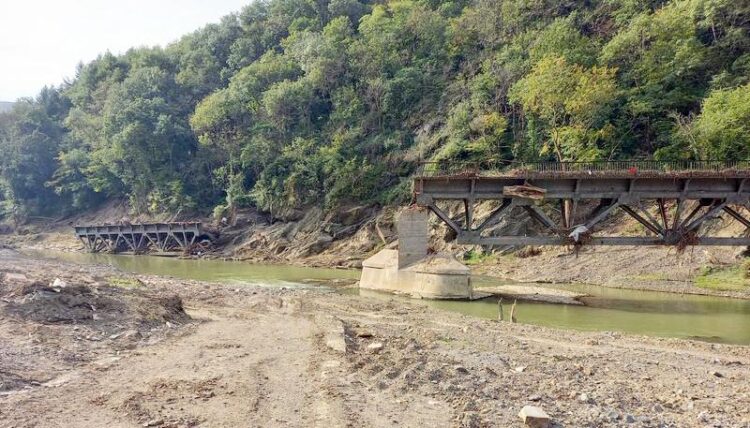Preparing flood-risk areas for climate change

This steel bridge, despite its weight and permeable construction, was swept away by the flood through dead wood and other materials.
(c) Jörn Birkmann
In carrying out the rebuilding work in the disaster areas along the River Ahr and other rivers in North-Rhine Westphalia, how can settlements and infrastructure be adapted to future heavy rain events and floods in order to reduce the numbers of victims and the amount of damage caused? This is being investigated by a team led by the spatial planner Prof. Jörn Birkmann from the University of Stuttgart and the water management expert Prof. Holger Schüttrumpf from RWTH Aachen. The project, which is predicted to start in November 2021, is receiving around EUR 5 million in funding from the German Federal Ministry of Education and Research (BMBF).
180 killed, EUR 30 billion in damage: the floods on the River Ahr and other rivers in North-Rhine Westphalia in July 2021 are among the biggest natural disasters to hit Germany since the Second World War, and these kind of extreme weather events may become more frequent as a result of climate change. The challenges for the regions affected are enormous, but Federal Minister of Education and Research Anja Karliczek believes that: “Rebuilding gives us an opportunity to make the region sustainable and resistant to climate change – making sure that people can live safely here once again. Our objective has to be to make sure that the regions can withstand extreme weather and other consequences of climate change.”
A scientific project involving experts from across Germany, including the clusters “Spatial Risk Management and Adaptation” (spokesperson Prof. Jörn Birkmann, Institute of Regional Development Planning at the University of Stuttgart (IREUS)) and “Flood Risk Analysis” (spokesperson Prof. Holger Schüttrumpf, RWTH Aachen), is intended to support this process. Other institutions involved include researchers from the University of Potsdam, the German Research Center for Geosciences (GFZ), the Helmholtz Center for Environmental Research (UFZ), the TU Kaiserslautern, the University of Koblenz as well as other partners from industry.
“We want to examine, for example, how it is possible to strategically promote settlements and infrastructure which are adapted to flooding events beyond the legally determined flood areas. This includes the question of how and where large quantities of water can be diverted so that they don’t cause as much damage and claim as many lives as happened in 2021”, explains Jörn Birkmann.
For example, this can be done through creating emergency water channels or by deliberately diverting heavy rain towards playing fields or waste ground in towns and villages. It should also be investigated which households want to move away from the river, and whether there are places in their local areas which offer a high degree of safety against extreme weather events. This isn’t just a question of how exposed a site is, explains Birkmann, but it takes into consideration issues of vulnerability. “Single-floor school buildings right next to small rivers for example are not helpful, because in case of a flood it would not be possible to evacuate children – a particularly vulnerable group – to a higher floor.”
Wissenschaftliche Ansprechpartner:
Prof. Jörn Birkmann, University of Stuttgart, Institute of Regional Development Planning, Tel. +49 711 685-66333, E-mail joern.birkmann@ireus.uni-stuttgart.de
Media Contact
All latest news from the category: Architecture and Construction
Newest articles

Bringing bio-inspired robots to life
Nebraska researcher Eric Markvicka gets NSF CAREER Award to pursue manufacture of novel materials for soft robotics and stretchable electronics. Engineers are increasingly eager to develop robots that mimic the…

Bella moths use poison to attract mates
Scientists are closer to finding out how. Pyrrolizidine alkaloids are as bitter and toxic as they are hard to pronounce. They’re produced by several different types of plants and are…

AI tool creates ‘synthetic’ images of cells
…for enhanced microscopy analysis. Observing individual cells through microscopes can reveal a range of important cell biological phenomena that frequently play a role in human diseases, but the process of…





















